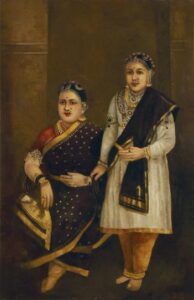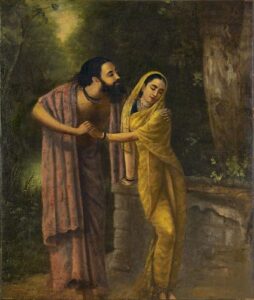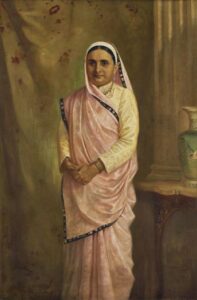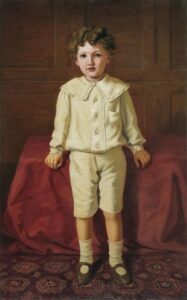Reviving the Past: A journey through the artistic genius of Raja Ravi Varma

Called Father of Modern Indian Art, Raja Ravi Varma was born on April 29, 1848
Sneha Gautam
One of India’s most famous and revered artists, Raja Ravi Varma was born on this day (April 29) in 1848 in Kilimanoor, Travancore. Adopting themes that appealed to the elite and later attracted the masses, he came to be celebrated for his portraits that featured royalty, women, gods, and goddesses. He skillfully bought together Indian traditions along with European academics in art. He was influenced by his many travels around the Gujarat State. A painterly genius who continues to inspire and influence generations, he is also considered one of Navratna or ‘Nine Gems’ of Modern Indian Art. On the occasion of his birth anniversary, here are some well-known and lesser-known facts about Raja Ravi Varma expressed through the perspective of some of his unique works.
In 1870, Raja Ravi Varma received his first commission for a family portrait for Kizhakke Palat Krishna Menon, who was a sub-judge of the Calicut Court. From there on, he slowly but steadily built his reputation as a renowned court painter and was commissioned by Royal families all over India to paint portraits. Between 1878 and 1895, Raja Ravi Varma and his brother extensively toured places like Baroda, Pudukkottai, Mysore, Agra, Oudh and Madras to execute the various portraits commissioned to them by Royalty. Raja Ravi Varma arrived at the Pudukkottai court in 1878 on the invitation of Seshaiah Sastri and the Raja of Pudukkottai Ramachandra Tondaiman. Pudukkottai was a small state in what is now Tamil Nadu, where Raja Ramachandra ruled from 1839 to 1886.
During his first visit to the Pudukkottai court, he painted several commissioned works that included a portrait of Raja Ramachandra Tondaiman and H. H. Janaki Subbamma Bai Sahib, the Rani of Pudukkottai. During Raja Ravi Varma’s second visit to the Pudukottai court in the year 1886, he once again painted several members of the Royal family, including that of the Rani and her daughter, as well as the darbar scene of the Pudukkottai court.
Raja Ravi Varma came to be most famous for his scenes inspired by epic Indian mythology, especially the Ramayana and Mahabharata. He was famed for sculpting images of Hindu Deities, opening up a portal of divinity for the people of India.
One such work is a painting titled Arjun And Subhadra, executed Circa 1890. This oil on canvas creation by Raja Ravi Varma is a stellar composition where he highlights the eternity of love and its attributes of surrendering. Here he depicts Arjuna disguised as a Sanyasi with Balarama’s daughter Subhadra, capturing a moment of their playfulness. The visual aspects are a sheer treat, but what mesmerises the viewers is the direct impact of the presence of the moment which is intact. He was famed for sculpting images of Hindu Deities, opening up a portal of divinity for the people of India. However, this painting is his channel of artistic expression. He depicts a deity but makes the entity much more relatable to the mortal viewer, framing the Godly figure with traits of mortal needs and longings and yet establishing their heavenly grace and eloquence.
Aiming to reproduce prints of his works to be made available to a wider audience, the artist arrived in Bombay in 1881 to raise money to set up ‘Ravi Varma Fine Arts Lithographic Press’ which came into being in 1894. During these years, he did a series of commissioned portraits of affluent and famous people in Bombay.
One of these portraits was that of Bai Sunabai Temuljee Nariman, executed with oil on canvas creation in 1896. She was a revered figure for her active philanthropy and social work. Particularly commendable is the role she had to play in the proper functioning and supervising of the Parsi Lying-in Hospital. The Parsi Lying-in Hospital was one of the first Maternity hospitals in Mumbai and played a huge role in alleviating the suffering of women during those times. Her husband, Temuljee Bhicaji Nariman, was one of the co-founders of the hospital. By painting a portrait of this magnificent lady, who did so much for the community, Ravi Varma gloriously etched her place in the history of Bombay.
In 1904, Raja Ravi Verma was conferred with the Kaisar-i-Hind Gold Medal, bestowed upon him by Viceroy Lord Curzon on behalf of the British King-Emperor. A college in Mavelikara, Kerala, dedicated to Fine arts was also constituted in his honour.
During this period, he came under the patronage of the 2nd Baron Ampthill Oliver Russell. A British peer and administrator, Russell served as the Governor of Madras from October 1900 to February 1906. He was also in the position of the Viceroy of India from April to December 1904. This coincides with the year that 2nd Baron Ampthill commissioned Raja Ravi Varma to paint a portrait of his son, dated 1904.
Sneha Gautam is Senior Vice President, AstaGuru Auction House






